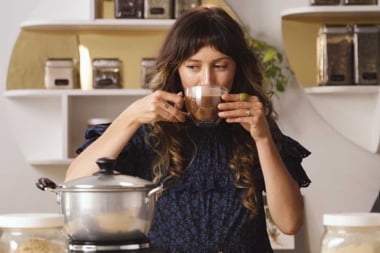
The yellow Cavendish banana that we know and love could face eradication by Panama disease in the future. Its replacement is the sweet, nutritious red banana.
The simple yellow banana that we slice into our breakfast cereal every morning is a variety called the Cavendish. Although it is only one of about 1,000 varieties, it accounts for 95 percent of the international trade in bananas.
Unfortunately, a fungus called Panama disease has infected the Cavendish, and experts estimate that we have only five to 10 years left with the yellow breakfast fruit that we know and love.
Gros Michel precedes Cavendish
The Cavendish was not always the world’s most popular banana. Until WW II a variety called the Gros Michel was the only banana available to North American markets. Bigger than the Cavendish, the Gros Michel was chosen for widespread production and distribution because its thick skin made it easy to transport without damage.
Panama disease struck the Gros Michel almost as soon as it was introduced to the Americas. The disease wipes out entire plantations and, in order to maintain production, banana companies were obliged to constantly move and establish new plantations. Plantation and plague cycled across the banana-producing world until there was no more disease-free
land available.
Cavendish as default choice
Throughout this period banana companies searched for a viable replacement for the Gros Michel. Our Cavendish was known and available for production, but banana companies considered it such an inferior product that they resisted its introduction until they were on the brink of extinction themselves.
Companies finally adopted the Cavendish because at the time it was still immune to Panama disease.
Genetic strength and weakness
Bananas are practical and reliable for market because they are grown in monocultures. The stem of a banana plant sends out dozens of underground shoots, called suckers. These suckers are harvested and replanted to form a new banana plant.
This means that all bananas of a single variety are genetically identical. This is the plant’s strength—and its weakness. Because they are genetically identical, all bananas will ripen at the same rate, taste the same, require the same shipping methods and, unfortunately, fall prey to the same disease.
History repeats itself
The Cavendish remained immune to Panama disease until it was introduced to Asia in the 1980s. In Asia there are many banana varieties, and these varieties live with many and varied pathogens to which they cyclically resist and succumb.
The Cavendish had not lived with these various pathogens and had no resistance. When the Cavendish was introduced to Asian soil and its various pathogens, a virulent strain of Panama disease found a home and began to spread.
Battling Panama disease
There are three current approaches to the problem of Panama disease:
- Growers are attempting to manage the spread of the disease in their planting and cultivation practices, removing spores from suckers before they replant them. This method is not 100 percent effective and is time consuming.
- Growers and scientists are searching for new hybrids that are immune to the disease. Bananas are very slow to grow, so scientists are trying to jumpstart traditional hybridization processes with genetic engineering.
- Just as a monoculture will ensure an epidemic, the only way to maintain plant resistance is through crop diversification.
Red bananas
Grown in South America and Asia, red bananas are imported to Canada and sold widely in produce markets and supermarkets. Red bananas are sweeter and even more nutritious than the yellow Cavendish. But, along with their sweet taste and impressive nutrient content, there is another good reason to try this sweet red fruit. Choosing red bananas maintains banana diversity, which may help avoid the pitfalls of monoculture.
10 reasons to try a red banana
- Red bananas contain very high levels of beta carotene, which the body converts to about 15 percent of the recommended daily intake of vitamin A.
- One red banana contains 20 percent of the recommended daily intake of vitamin B6, which supports both the immune and nervous systems.
- One red banana provides 15 percent of the recommended daily intake of vitamin C, an essential antioxidant and, of course, an important support to the immune system.
- Red bananas are high in magnesium, which supports the immune and nervous systems; potassium, which eliminates excess sodium from the body; and manganese, which is essential to the body’s use of the B vitamins.
- It is easy to judge the nutritional value of red bananas for yourself: The brighter red the skin, the higher the value of beta carotene; the firmer the banana, the higher the mineral content.
- One red banana provides 16 percent of the daily dietary fibre intake.
- Red bananas have no fat and no cholesterol.
- Red bananas are sweeter than our yellow Cavendish bananas.
- Red bananas have a slight raspberry flavour.
- Red bananas come in their own purpley-red package!




